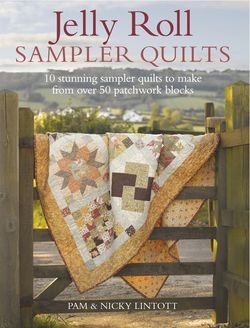Читать книгу Jelly Roll Sampler Quilts - Pam Lintott - Страница 6
На сайте Литреса книга снята с продажи.
ОглавлениеIMPORTANT TECHNIQUES
We had so many blocks to put into this book we felt giving these important techniques at the beginning would not only make an easy reference point but also give us more space for blocks and quilts. All the blocks in our sampler quilts are formed from squares, rectangles, half-square triangle units, quarter-square triangles and rectangles with flip-over corners (flying geese units). These instructions need to be referred to when making the blocks. If you are using a speciality ruler other than the Multi-Size 45/90 please make sure you are cutting on the correct lines. The Multi-Size 45/90 shows the finished size markings so if you are using another ruler do check before cutting. General techniques are described at the end of the book.
MAKING HALF-SQUARE TRIANGLE UNITS WITH THE MULTI-SIZE 45/90 RULER
1 Take a dark strip and a light strip and press right sides together, ensuring that they are exactly one on top of the other. The pressing will help hold the two strips together.
2 Lay the strips out on a cutting mat and position the Multi-Size 45/90 as shown in the diagram, lining up the 2in mark at the bottom edge of the strips. Trim the selvedge and cut the first triangle. You will notice that the cut out triangle has a flat top. This would just have been a dog ear you needed to cut off so it’s saving you time!
3 Rotate the ruler180 degrees as shown in the diagram and cut the next triangle. Continue along the strip, alternating in this way to cut the required number of triangles.
4 Keep the two triangles right sides together, pinning if desired. Using a ¼in seam, sew along the diagonal to form a half-square triangle unit. Trim all dog ears and press open with the seams pressed towards the darker fabric. These half-square triangles will make a 2in finished unit.
MAKING QUARTER-SQUARE TRIANGLES WITH THE MULTI-SIZE 45/90 RULER
1 Position the Multi-Size 45/90 on the fabric strip, as shown in the diagram below, lining up the 4in marker line with the bottom of the strip. Cut either side of the ruler to form one triangle.
2 Rotate the ruler 180 degrees and cut another triangle. Continue along the strip in this way to cut the required number of triangles.
3 Pin two triangles right sides together. Using a ¼in seam, sew along the side. Repeat this with two more triangles.
4 Pin the two triangle units together, aligning the centre neatly. Sew together and press open. These quarter-square triangles will make a 4in finished square.
MAKING FLYING GEESE UNITS
1 These flying geese units are made with flip-over corners. Take a 2½in square allocated to make the flip-over corner and lay it right sides together on a rectangle. Sew across the diagonal. If it helps, draw the diagonal line in first or make a fold to mark your stitching line.
2 Flip the square over and press towards the corner. Trim the excess fabric from the corner square but do not trim the excess fabric from the rectangle as, although this creates a little more bulk, it does help to keep your work in shape. Repeat on the other side to create a flying geese unit.
SEAMS
We cannot stress enough the importance of maintaining an accurate ¼in seam allowance throughout when making a quilt. We prefer to say an accurate scant ¼in seam because there are two factors to take into consideration. First, the thickness of thread and second, when you press your seam allowance to one side, it takes up a tiny amount of fabric. These are both extremely small amounts but if they are ignored you will find your exact ¼in seam allowance is taking up more than ¼in.
SEAM ALLOWANCE TEST
It is well worth testing your seam allowance before starting on a quilt and most sewing machines have various needle positions which can be used to make any adjustments.
Take a 2½in strip and cut off three segments each 1½in wide (diagram A). Sew two segments together down the longer side and press the seam to one side. Sew the third segment across the top – it should fit exactly. If it doesn’t, you need to make an adjustment to your seam allowance. If it is too long, your seam allowance is too wide and can be corrected by moving the needle on your sewing machine to the right. If it is too small, your seam allowance is too narrow and this can be corrected by moving the needle to the left.
